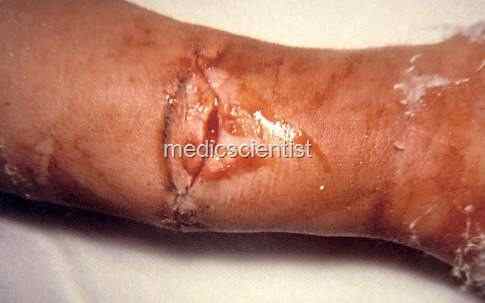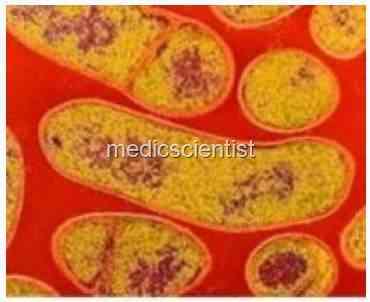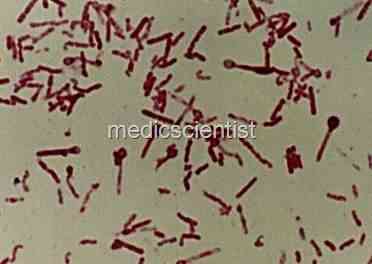Home » Diseases & Diagnosis » Bacterial Infections TETANUS Causes Diagnosis Treatment with Signs and Symptoms
Bacterial Infections TETANUS Causes Diagnosis Treatment with Signs and Symptoms
All about Bacterial Infections Caused by Gram-Positive Clostridium tetani with diagnosis Treatment Signs and symptoms
|
|
|
Bacterial Infections clostridium tetani
|
TETANUS
- Tetanus is a neurological disease caused by clostridium tetani characterized by increased muscle tone and spasms due to a powerful exotoxin tetanospasmjnproduced by the bacteria.
- C. tetani is a Gram positive anaerobic rod with a terminal spore resembling a tennis~racket.
|
|
|
TETANUS Causes Diagnosis Treatment with Signs and Symptoms
|
Clinical manifestations TETANUS:
- There is increased muscle tone and generalized spasms.
- It occurs 3 – 13days after an injury such as a puncture wound, laceration or abrasion. It is also associated with burns, surgery, abortion, child birth, gangrene.
- There is increased tone in the masseter muscles (jaw muscles) resulting in tri.smus or lock-jaw.
- Lock-jaw is the first feature of tetanus.
- ~There is dysphagia, stiffness of neck, shoulder and back muscles.
- The abdomen is rigid.
- Hands and feet are spared but proximal limb muscles are involved.
- There is risus sardonicus (sarcastic smile) due to sustained contraction of facial muscles.
- There is opisthotonus (arched back). There may be cyanosis and respiratory distress.
- Convulsions are provoked by any stimulation like noise, light etc.
- Patient may have fever.
- Deep tendon reflexes are exaggerated.
- There may be tachycardia, hypertension, arrhythmias, laryngeal spasm, respiratory arrest and cardiac arrest.
- Diagnosis is usually clinical.
Treatment OF TETANUS
- General supportive measures. Respiratory support.
- Airway is protected.
- Wound is cleaned and debrided.
- Penicillin 10 – 12 million units daily IV for 10 days.
- Metronidazole 500 mg §…b.r:l¥.
- Clindamycin, Erythromycin.
- V Antitoxin-human tetanus immune globulin is given to neutralize circulating toxin in the wound. Dose is 3000 – 6000 units intra muscular in divided doses.
- Equine tetanus antitoxin may be used instead of. human antitoxin.
- Muscle spasms are controlled by Diazepam, Lorazepam, Propofol, Magnesium sulphate.
- Respiratory care – Tracheostomy and Mechanical ventilation.
Prevention OF TETANUS :
- Active immunization – consists of 3 doses of tetanus toxoid – 1st and 2nd doses are given 1 -2 months apart, 3rd dose is given after 6 – 12 months. Booster dose is given every 10 years.
 |
| neurotoxins produced by Clostridium botulinum |
- Botulism is a paralytic disease caused by neurotoxins produced by Clostridium botulinum.
- There is cranial nerve involvement and the disease progresses downwards to the extremities.
- Botulism may be food-borne, or wound botulism, or intestinal botulism.
- Botulism occurs worldwide.
- Botulinum toxin can be dispersed in an aerosol or mixed with food. Therefore, it is used in biological warfare and terrorism.
 |
| Clostridium botulinum |
Clinical features BOTULISM:
- There may be a mild ill ess or a severe disease resulting in death ithin 24 ho!J.[s.
- Incubation period is 1 – 2 days.
- -There is symmetrical descending paralysis with respiratory failure and death.
- -There is cranial nerve involvement, diplopia, dysarthria, dysphagia.
- There is nausia vomiting ,abdominal pain, dizziness, depressed pupillar reflexes, and decreased, deepaondon reflexes.
- Diagnosis is by demonstration of the organism or its toxin in vomitus, gastric fluid or stool.
Treatment BOTULISM :
- Patients should be monitored and managed for respiratory failure.
- Equine anti-toxin is given as soon as the case is diagnosed.
 |
| GAS-GANGRENE disease is caused by Clostridium perfringens |
GAS-GANGRENE
- This disease is caused by Clostridium perfringens. They cause food poisoning, enteritis necroticans (necrotizing enteritis), suppurative deep tissue infections, skin and soft tissue infections, gangrene (Clostrid ial myonecrosis}.
- reatment is cleaning and debriding the wound, Penicillin G 20 units/day or Clindamycin.
Therapeutic Division & Details :: Medicine Content or Salt & Details ::






